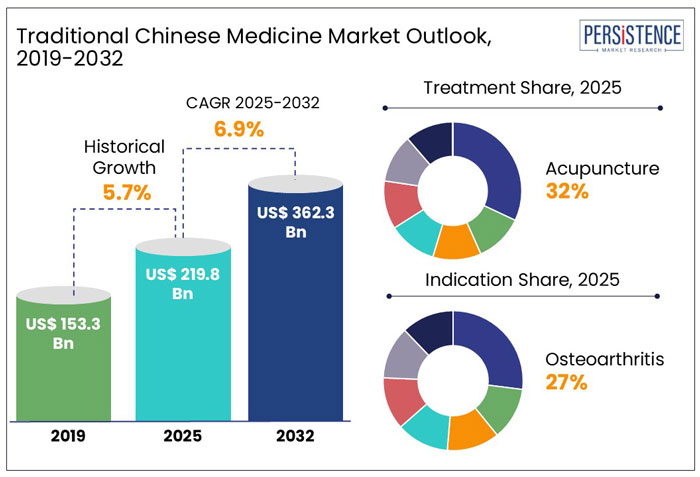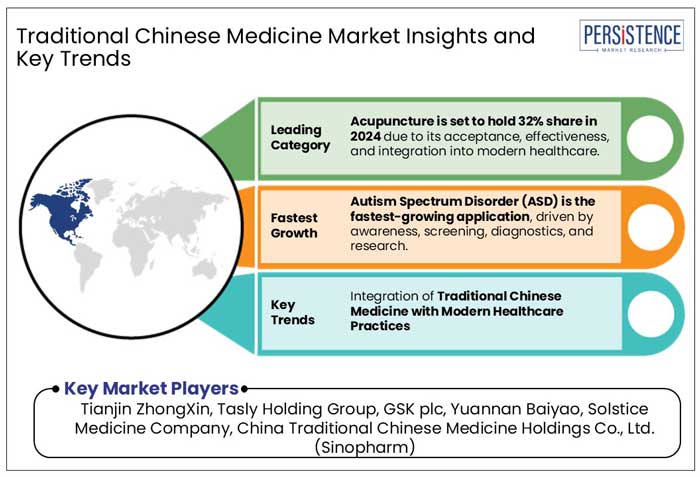ID: PMRREP16219| 193 Pages | 21 Feb 2025 | Format: PDF, Excel, PPT* | Healthcare

The global market for Traditional Chinese Medicine is estimated to value at US$ 47.8 Bn by the end of 2032 from US$ 33.3 Bn recorded in 2025. The market is expected to secure a CAGR of 5.3% in the forthcoming years from 2025 to 2032.

|
Market Size (2025) |
US$ 33.3 Bn |
|
Projected Market Value (2032) |
US$ 47.8 Bn |
|
Global Market Growth Rate (2025 to 2032) |
5.3% CAGR |
|
Market Share of Top 5 Countries |
74.2% |
As assessed by Persistence Market Research, non- Traditional Chinese Medicine held dominating stance in global market. Attention Deficit Hyperactivity Disorder (ADHD) led this category within the global market with value share of around 85.9% in the global market, in 2024. Overall, traditional Chinese medicine market sales account for around 18.5% of revenue share in the global herbal medicines market, which was valued at around US$ 155 Billion in 2024.
The global market recorded a historic CAGR of 5.1% in the last 6 years from 2019 to 2024.
A form of complementary treatment known as traditional Chinese medicine (TCM) was derived from Chinese traditional medicine. Traditional Chinese medicine included a variety of frequently conflicting health and healing philosophies, folk beliefs, literati theory, and Confucian principles, as well as herbal cures, nutrition, exercise, and medical specialty.
Chinese cultural and political modernizers tried to eradicate traditional traditions as antiquated and unscientific during the early twentieth century. Then, traditional practitioners arranged what they referred to as "Chinese medicine" by choosing certain components of theory and practise. The Chinese government supported the fusion of Chinese and Western medicine in the 1950s, and throughout the 1960s Great Proletarian Cultural Revolution, it marketed Chinese medicine as accessible and affordable.
Traditional Chinese medicine use practices such as Tai chi, meditation, acupuncture, herbs, cupping, and moxibustion. It is widely recognised that acupuncture can be used to treat a variety of conditions, including pain management and reducing the negative effects of chemotherapy. Several TCM medicines are also utilised in reputable Western medical facilities to treat conditions like menopause, arthritis, and sleep disorders. Tai chi appears to help Parkinson's patients with their balance. Using cups to treat shingles pain may be beneficial.
TCM is founded on notions about qi, a life force that is thought to flow through meridians and support the body's ability to maintain health. In order to access any of the thousands of places along the meridians where the flow of qi can be changed to improve health, acupuncture needles are inserted into the skin. Treatments, including acupuncture and herbal medicines, are claimed to function by rebalancing the yin and yang forces.
TCM practitioners and Western-trained doctors have frequently regarded one another with suspicion. The custom in the West is to look for clear-cut, tried-and-true factors to account for a disease state. It often calls for randomised, controlled clinical studies that offer quantifiable proof that a drug is effective.
The global market is likely to show high growth over the coming years at a CAGR of 5.3% and reach a global market size of US$ 47.8 Bn by 2032.
“TCM Formulations are Subject to More Research.”
The development of new laws, expanded funding options, and more public-private partnerships, are pushing for innovative joint research prospects in TCM medication formulations. To generate the Chinese medical raw materials, more than 600 plant bases are used by both Chinese and non-Chinese players.
The creation of plant extracts from Poria cocos, Panax ginseng, Acorus gramineus, Schisandra chinensis, and Glycyrrhiza uralensis has received a lot of attention lately. Demand for these TCM formulations is anticipated to increase in the upcoming years due to the continuous emphasis on unmet medical requirements in herbal extract-based medications.
The need for TCM treatment has been developing globally because of an increase in paediatric disorders, chronic behavioural diseases, growing public awareness of mental health, and increased prevalence of lifestyle diseases including ASD and ADHD issues. The demand for and production of alternative and over-the-counter medicines has surged due to the elevated danger associated with non-TCM pharmaceuticals.
TCM practises like nutritional treatment, acupuncture, and massage can help patients treat diseases. In order to improve their score on the Childhood Autism Rating Scale (CARS), acupuncture and herbal therapies are routinely given to children suffering with ASD in addition to regular therapy.
Industry experts have observed that over the past three years, there has been a rise in the demand for low-cost TCM in the developing countries of the Asia Pacific and East Asian areas as a result of a rise in the local pharmaceutical manufacturing sector.
The need for more effective, high-quality TCM formulations is increasing in industrialised economies compare to emerging countries. Government initiatives in countries like China, India, Africa, and Brazil, are boosting profits from the production of TCM and non-TCM drugs and associated healthcare services.
“Inadequate Supply of High Quality TCM Formulations Compared To Superior Alternatives.”
High quality herbal extracts and excipients, which could help with the development of plant-based medications, are in great demand, but there is a big supply gap. Basic pharmacological formulations for the treatment of ASD and ADHD include herbal APIs and excipients, which increases the risk of side effects and poses issues with regard to potency.
High quality TCM extracts are currently only available from a small number of cGMP-certified sources and manufacturing facilities, which could help formulation development. The formulation and length of treatment of currently tested herbal treatments varies.
Alternative innovations have an impact on market growth during the projected period. Q Biomed submitted an application for orphan drug designation with the USFDA in June 2018, for the development of QBM-001, which will be utilised in juvenile patients with verbal autism.
Why is the United States Market Booming?
“Cost Effectiveness of Traditional Chinese Medicine”
The United States accounted for around 82.9% market share in the North America market in 2024. Over the past few decades, traditional medicine study has been steadily present and expanding in the United States. These procedures have minimal to no evident negative effects and generally inexpensive prices. One of the most well-liked traditional medical systems for managing chronic health issues or enhancing general quality of life is traditional Chinese medicine.
Growing chronic disorders in the region has driven the regional market.
Will the United Kingdom Be a Lucrative Market for Traditional Chinese Medicine?
“Growing Adoption of Acupuncture and Moxibustion Practices”
The United Kingdom market held around 18.6% market share of the Europe market in 2024. The regional dominance is attributed to increasing utilization of TCM practices such as acupuncture, Chinese herbal medicines, and moxibustion.
Many different diseases are treated with traditional Chinese medicine in the region. These factors are responsible for the regional dominance.
How is China Emerging as a Prominent Market?
“Increasing Use of TCM in Nursing Homes”
China held a market share of about 3.2% of the global market in 2024. TCM has a long history of use in China, and its customs, religious beliefs, popularity, and anecdotes all support this viewpoint. The majority of Chinese people choose TCM over Western medicine because they think it has fewer negative effects and a healing effect on the body.
Use of TCM in nursing homes for treating patient in nursing facilities has increased the demand of TCM in the region.
Which Product is Driving Demand within the Global Market?
“Increasing Benefits of TCM”
The non-traditional Chinese medicine segment held around 82.2% share of the total market in 2024. Traditional Chinese medicine offers a number of benefits for the physical and mental health of many people. TCM enhances fertility, maintains hormonal balance, and reduces pain and inflammation. It also lessens the body's reaction to stress.
The demand for TCM has grown over the anticipated period due to additional benefits such how it supports body flexibility and balance and helps with the healing process after injury.
Which Disease is Widely Adopted of Traditional Chinese Medicine?
“Properties of Rehmanniae Radix Preparata as TCM for ADHD”
Attention deficit hyperactivity disorder (ADHD) held around 86.1% share of the total market in 2024. The Rehmannia root is wine-steamed to produce Rehmanniae radix preparata, a scrophulariaceae plant. It has been used for hundreds of years and has the advantages of nourishing kidney-yin, boosting essence, and filling the marrow, according to traditional Chinese medicine (TCM) theory. Rehmanniae radix preparata contains anti-inflammatory, anti-oxidant, anti-senescence, and neuroprotective properties.

Exclusive distributorship for research and development, manufacturing and commercial purpose are few key strategies opted by leading players within this market space.
Some key instances of development include:
Similarly, the team at Persistence Market Research has tracked recent developments related to companies in the traditional Chinese medicine market, which are available in the full report.
The global market is expected to be valued at around US$ 33.3 Bn in 2025
The global market is anticipated to reach a valuation of around US$
47.8 Bn by the end of 2033.
Sales of the market are set to grow at a CAGR of 5.3% between 2025 and 2032.
The U.S., Canada, Brazil, China, and Mexico account for most demand within the market, currently holding around 74.2% market share.
Sales of the market are set to grow at a CAGR of 5.3% between 2025 and 2032.
The U.S. accounts for around 82.9% share of the North American market in 2024.
The U.S., Canada, Brazil, China, and Mexico account for most demand within the market, currently holding around 74.2% market share.
China held a market share of about 3.2% of the global market in 2024.
The U.S. accounts for around 82.9% share of the North American market in 2024.
The ADHD disease segment is responsible for traditional chinese medicine market with 86.1% market share.
China held a market share of about 3.2% of the global market in 2024.
The U.K. market held around 18.6% market share of the Europe market in 2024.
The ADHD disease segment is responsible for traditional chinese medicine market with 86.1% market share.
The U.K. market held around 18.6% market share of the Europe market in 2024.
|
Attribute |
Details |
|
Forecast Period |
2025 to 2032 |
|
Historical Data Available for |
2019 to 2024 |
| Market Analysis Units | Value: US$ Bn/Mn, Volume: As applicable |
|
Key Countries Covered |
|
|
Key Market Segments Covered |
|
|
Key Companies Covered |
|
| Report Highlights |
|
|
Customization & Pricing |
Available upon Request |
Product:
Disease:
Region:
Delivery Timelines
For more information on this report and its delivery timelines please get in touch with our sales team.
About Author